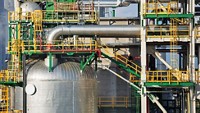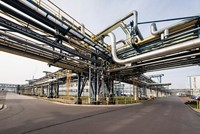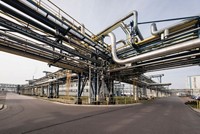Advertisement
Grab your lab coat. Let's get started
Welcome!
Welcome!
Create an account below to get 6 C&EN articles per month, receive newsletters and more - all free.
It seems this is your first time logging in online. Please enter the following information to continue.
As an ACS member you automatically get access to this site. All we need is few more details to create your reading experience.
Not you? Sign in with a different account.
Not you? Sign in with a different account.
ERROR 1
ERROR 1
ERROR 2
ERROR 2
ERROR 2
ERROR 2
ERROR 2
Password and Confirm password must match.
If you have an ACS member number, please enter it here so we can link this account to your membership. (optional)
ERROR 2
ACS values your privacy. By submitting your information, you are gaining access to C&EN and subscribing to our weekly newsletter. We use the information you provide to make your reading experience better, and we will never sell your data to third party members.
Business
European Vinyls Giant Emerges
Plastics: Solvay, Ineos say joining together will help them tough out a rough marketplace
by Alexander H. Tullo
May 13, 2013
| A version of this story appeared in
Volume 91, Issue 19

In a further consolidation of the troubled European polyvinyl chloride industry, Belgium-based Solvay and Switzerland-based Ineos have agreed to pool their chlorine and PVC-related assets in a new joint venture.
The venture will be the second-largest PVC maker in the world, behind Shin-Etsu Chemical and just ahead of Formosa Plastics. The partnership will have $5.6 billion in annual sales and about $340 million in before-tax profits. It will operate 17 plants, all in Europe, and employ 5,650 people. The plants make PVC as well as raw materials such as chlorine, ethylene dichloride, and vinyl chloride.
The aim of the joint venture “is to improve its competitiveness in an environment which is, once again, a challenging one,” Solvay CEO Jean-Pierre Clamadieu told stock analysts last week. Europe has been a tough region for PVC makers in recent years. According to Solvay figures, European demand for the plastic, used in construction materials such as pipe, has declined 30% since 2007. Another European PVC producer, Kem One, recently declared bankruptcy.
PVC demand is being hit on all fronts by the weak European economy, according to Janet Wright, chlor-alkali and vinyls business manager at the consulting firm Tecnon OrbiChem. “This has impacted industries such as construction and automobile production, which consume vast quantities of PVC,” she says. “Governments have very little money to spend on infrastructure projects. Consumers are reluctant to spend on high-value goods such as cars and housing.”
Ineos CEO James A. Ratcliffe hopes consolidation of the two units will help. “The newly combined business, which will be of world scale, will be able to better respond to rapidly changing European markets and to match increasing competition from global producers,” he said.
Ineos, which is composed largely of the cast-off assets of large chemical companies, has been a consolidator in the European PVC industry. In 2011, it bought Tessenderlo’s PVC operations. Earlier this year, it announced the closure of smaller PVC-related operations at various European plants.
The partners, however, don’t plan to shutter manufacturing capacity, Clamadieu said. Instead, they will seek to reduce costs through greater purchasing power for raw materials and electricity.
For Solvay, the deal is a stepping-stone to an exit from the PVC business. In four to six years after the joint venture is formed, Ineos will have an option to buy out Solvay’s share for 5.5 times earnings plus $325 million in cash. In February, Solvay revealed its intention to sell off its Latin American PVC affiliate, Indupa.
Solvay’s interest in RusVinyl, a PVC joint venture with Russian partner Sibur, and its business in the packaging resin polyvinylidene chloride will not be included in the deal.
Neither of the parties is contributing any cash to the venture, though both are contributing liabilities such as debt and pensions.





Join the conversation
Contact the reporter
Submit a Letter to the Editor for publication
Engage with us on Twitter